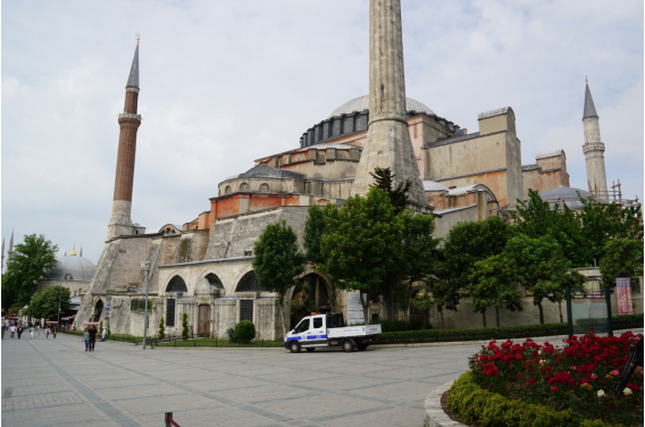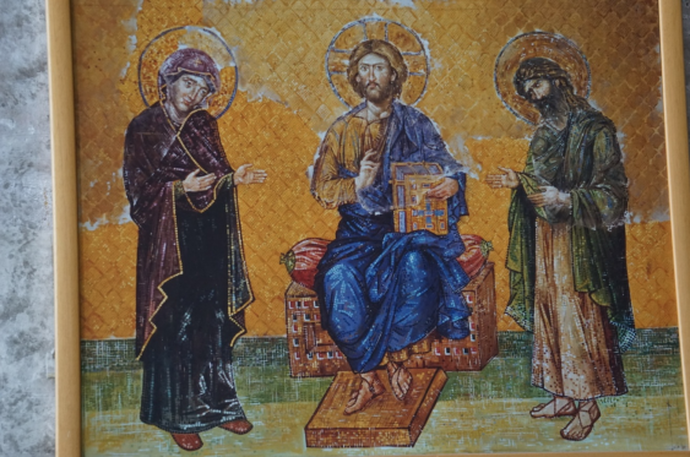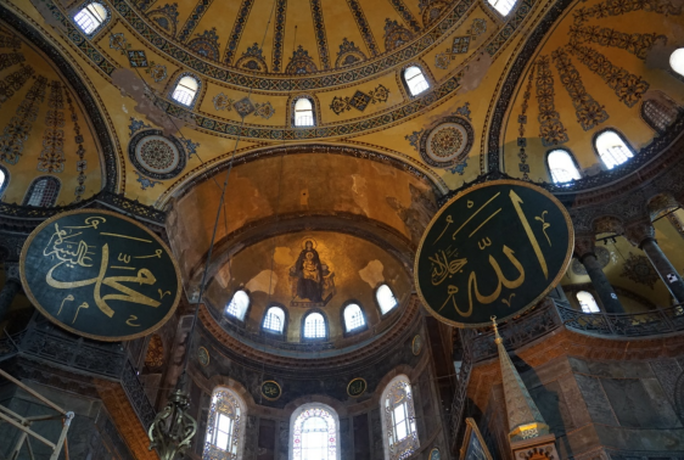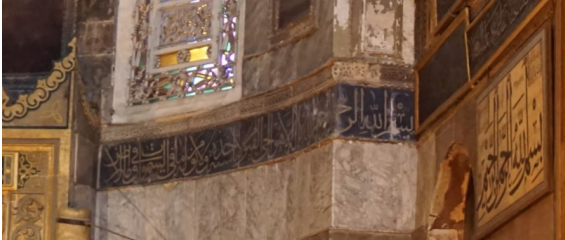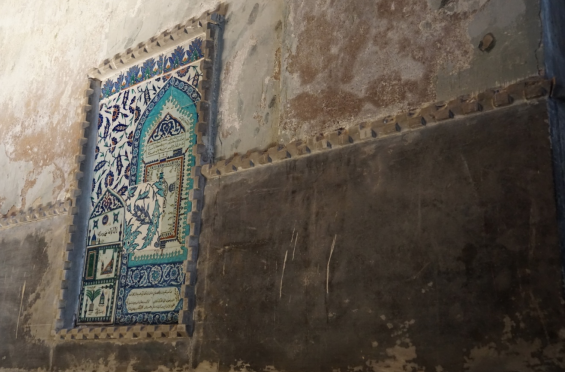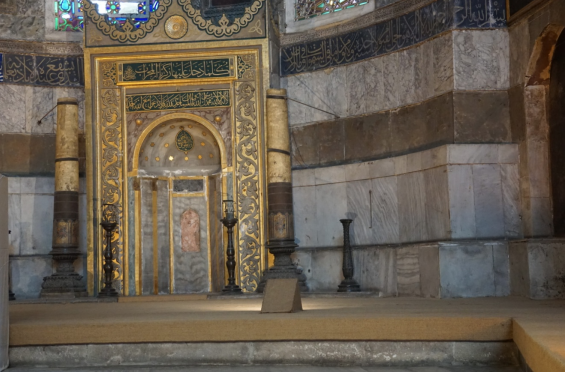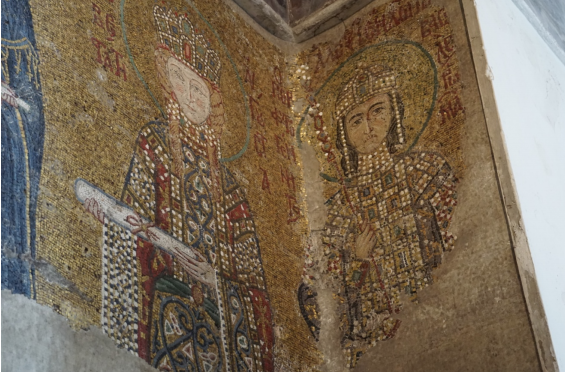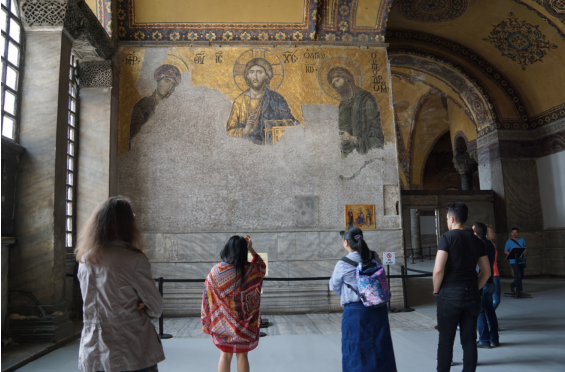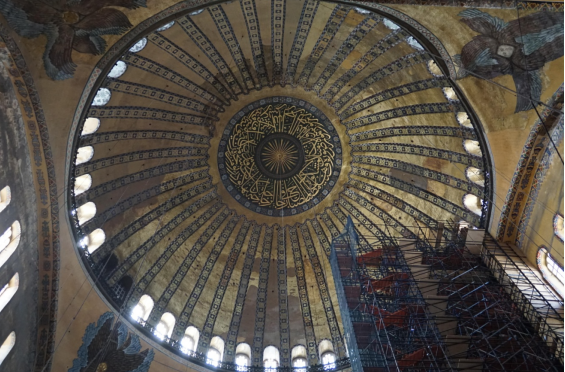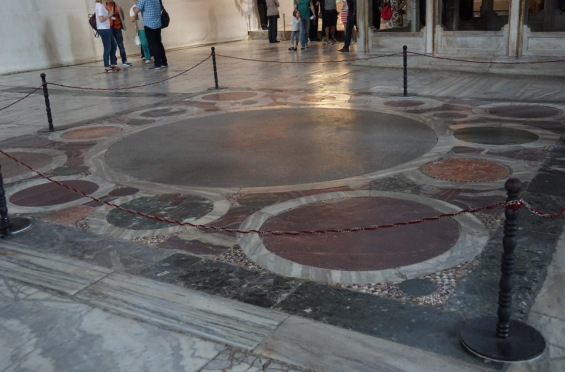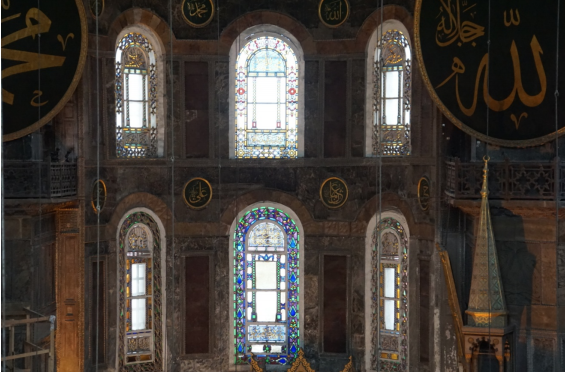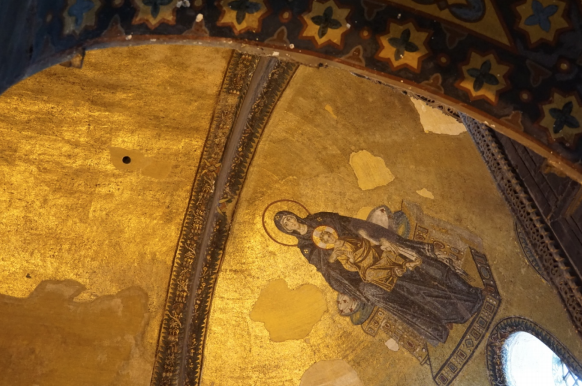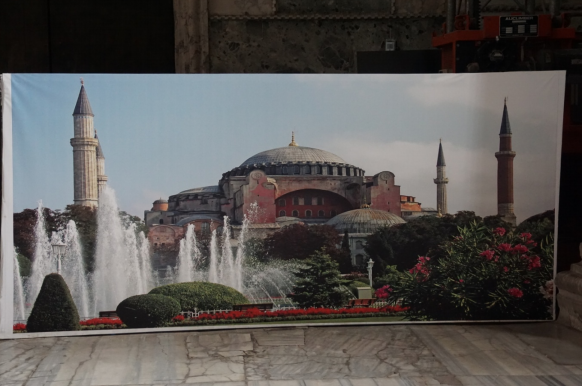|
Visual Arguments at the Hagia Sophia It is in the nature of religion to stake a claim for its own eternity, omnipotence, and permanence, yet paradoxically, since its initial construction in 360 A.D. the Hagia Sophia has been the site of fires, collapse, revolts, rioting, and earthquakes. It was ransacked by the Latin Christians during the fourth crusade, and indeed, its looted relics can still be seen in the museums of Western Europe. But perhaps the most radical event in its history was its transmutation into a mosque, in 1453, by Mehmet II, the Sultan of the Ottoman Empire, who conquered the city after a 54 day siege. The taking of the church was, as befits a medieval religious conflict, horrifyingly bloody and barbaric. When the Ottoman invaders battered down the doors, they found the women and children, as well as the elderly and the ill, all of whom had taken shelter from the invading forces, participating in the Divine Liturgy and Prayer of the Hours as they prayed for deliverance. The elderly and the sick were killed, the women were raped and older boys and teenage males were chained and sold into slavery. The church itself was ransacked and desecrated. One imagines that the Muslim looters recalled hearing about the previous desecration of the church during the capture of Constantinople by Latin Crusaders in 1204, when Enrico Dandolo, the Doge of Venice, commanded that the city be sacked and invaded, and all items of value, including the golden mosaics of the Hagia Sophia, were taken from the Byzantine buildings of the city and shipped to Venice. The treasure surely had tremendous symbolic value, as the building had been the focal point of the Eastern Orthodox Church for nearly one thousand years. *** Ataturk, the founder of the modern Turkish republic, had zero patience for the claims of religion. He secularized the building and re-inaugurated it as a museum in 1935. But the Hagia Sopha has not been a typical museum. It is more like a locus of confrontation, a visual iteration of the debates once staged in the Middle Ages, where sages of different religions would hold public debates in order to demonstrate the superiority of their faith. *** What a visitor to the Hagia Sophia in fact observes is a theological conflict playing out amongst the domes and mosaics, as well as the humble nooks and curious crannies, of the building. *** Wherever one turns, there is the uneasy juxtaposition of those who have claimed the place as their own. The two candlesticks, for example, that adorn the mihrab, placed facing Mecca in the spot where an altar once stood, were brought by the Ottoman Sultan Sulimet the Magnificent from the Cathedral of Buda, following his conquest of Belgrade, Rhodes and most of Hungary before being checked at the siege of Vienna in 1529. They stand in uneasy proximity to the two alabaster Helenistic urns brought by Murad III from Pergamon, in Western Turkey. *** Islam forbids the display of human likenesses on the walls of a mosque, so when the Church was converted, the Christian mosaics, with their explicit theological, philosophical and political messages, were deemed inaporpriate, and like troublesome children, the images peering from the walls of the building were covered up and put to sleep. When, in the 1930s the plaster was removed and the mosaics were revealed, it was as though long forgotten ancestors had returned to share their ideas about what beauty is, what power looks like and how the universe works. The faces on the walls that stare down at us suggest disturbing truths about the links between political influence and religion, and how these compliment and serve each other. Here for example, is a detail from the Comnenus mosaic, created in 1122. The Hungarian-born Empress Irene is offering a document to the Virgin (her blue robe is visible on the left side of the photo). Her son, Alexius, stands beside her. *** The Deesis, or "Entreaty" mosaic is said to date from 1261. It was commissioned to mark the return of Greek Orthodox control of the church after fifty-seven years of Roman Catholic hegemony. The scene shows the Virgin and John the Baptist imploring Christ Pantocrator to intercede for humanity on the Judgement Day. *** Wikipedia informs that the restorers tried to maintain a balance between Christian and Islamic elements. Of particular debate is the Arabic calligraphy in the center of the building’s dome, which is said to cover the Pantocrator mosaic portraying Christ as Master of the world. The Arabic script that may or may not conceal the mosaic speaks of God as the light of the universe. Pantocrator is a Greek term, a translation from the Hebrew terms YHWH, one of the names of God. It was the term used in the Septuagint, the first Greek translation of the Hebrew bible in the 3rd century BCE. The meaning of the word is “omnipotent” or “sustainer of the world." It is uncertain whether the mosaic still exists. The Fossarti brothers, Swiss-Italian restorers brought in to supervise work on the building from 1847-49, documented, repaired and then plastered over the faces of the four angels that surround the dome. The angels are considered to be seraphim, a Hebrew biblical term meaning “burning ones”, so named for their proximity to the throne of God. In 2009, Turkish restorers uncovered the face of one of these angels. Today, it looks down gloomily on the throngs of visitors who come from every corner of the earth, its features oddly human. *** When the mosque was converted to a museum in 1935, the carpets were lifted, revealing parts of the building that had been hidden for centuries, like this Omphalion, believed to be the sight of the coronation of the Byzantine emperors. Omphalos is a Greek word originating in ancient Hellenic mythology, meaning navel, as in the meeting place for two eagles sent across the world by Zeus to meet at its center, or the spot in the Church of the Holy Sepulcher in Jerusalem, where, according to Jewish tradition, God revealed himself. *** Ataturk’s agenda of political, economic, and cultural reforms aimed to replace the institutions and workings of the Ottoman Empire with a modern, secular nation-state. He forbade that the Hagia Sophia be used as a place of worship. Suddenly there was a quieting, a calming of what was once shrill and insistent. The Byzantine and Christian mosaics relaxed into art. The energetic swirls across the large cellular discs on which are inscribed the names of Allah, Mohamed, the first four caliphs and Mohamed’s grandsons, could make their point as though partaking in an academic discussion. The space morphed into an edifice proclaiming not the superiority of one belief system over another, but a temple of human endeavor. After all, centuries of physicists, mathematicians, architects, artisans, laborers, and restorers had given the best of their gifts to it. Dynasties of Emperors and Sultans financed it. And the believers − first Christians and later Muslims − had vested it with the power of faith. To enter into it today is to bear witness to the struggle to bestow meaning on the brevity and horror of existence. It is to feel the comforting promise that watching over us is a power that is orderly, moral, and compassionate. That it is possible to achieve a collective existence that is honorable, truthful, righteous and worthy. That however imperfect we are, these things are somehow in reach. *** In 2006 the Turkish government under Erdogan allowed a small room in the museum to be used as a prayer room for both the Christian and the Moslem staff. In 2007, Greek American politician Chris Spirou created an international organization dedicated to restoring the Hagia Sophia to its original function as a church, while officials in the Turkish government started demanding that it revert back to functioning as a mosque. On July 1, 2016, Muslim prayers were held again in the Hagia Sophia for the first time in eighty-five years. In July 2020, a Turkish court revoked the building’s status as a museum. Under its new classification, despite condemnation from the Turkish opposition, UNESCO, and the World Council of Churches, the Hagia Sophia is once again a Muslim house of prayer. Janice Weizman Photos courtesy of the author. Janice Weizman is the author of the award winning historical novel, The Wayward Moon. Her writing has appeared in World Literature Today, Ha'aretz, Queen’s Quarterly, and many other places.
0 Comments
Your comment will be posted after it is approved.
Leave a Reply. |
The Ekphrastic Review
COOKIES/PRIVACY
This site uses cookies to deliver your best navigation experience this time and next. Continuing here means you consent to cookies. Thank you. Join us on Facebook:
July 2024
|
